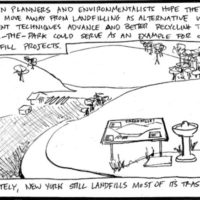Tags: landfills
How to make a worm composting bin
New York City throws over 3,000 tons of organic matter into landfills every day. Time to start composting! Craft-zine’s blog offers a guide to setting yourself up for indoor, home vermicomposting; the Lower East Side Ecology Center offers supplies and more information on composting in general.
...MORERenewables upon renewables
An interesting public-private partnership in renewable energy production and use: at the Pennsauken Sanitary Landfill in New Jersey, the rooftops of a landfill gas-to-energy plant and a nearby aluminum extrusion factory are occupied by a photovoltaic array. Some of the energy generated by the array is used to draw methane gas out of the landfill and into the gas-to-energy plant.
...MOREHow green is waste-to-energy?
Representatives from some of the country’s largest waste management companies have been lamenting the lost potential of President Obama’s green stimulus bill to directly support the growth of waste-to-energy operations. The US is currently dishing out $60 billion in energy grants and tax breaks meant to reduce dependence on coal plants blamed for global warming–but unlike wind or solar, none of that money is directly designated for waste-to-energy.
...MOREThe long tradition of garbage to green
We’re often asked whether there are other landfills in the world that have been turned into parks and natural areas. There are, in fact, a lot of them, including many hundreds to thousands of unofficial dump sites and historic landfills whose operation preceded any type of government regulation (Flushing Meadows, we’re looking at you).
...MORENJ Meadowlands landfill to go solar
Another case study we’re looking at: The New Jersey Meadowlands Commission (NJMC) has proposed the construction of a 5 MW solar farm to be built on top of the Erie Landfill. This would be the largest solar array built in New Jersey to date and could potentially power up to 600 homes per year.
...MORESolar covered landfill
Republic Services, Inc. has covered portions of its Tessman Road Landfill in San Antonio, TX with 1000 flexible, laminate-type photovoltaic (PV) solar collection strips that are configured to maximize the hours of sunlight exposure throughout the year, based on the landfill’s design and site contours.
...MOREEnlightenment? Or just the economy?
New Yorkers are throwing less stuff away now than they were three years ago. That’s according to Steve Cohen on his blog at The Observer. Apparently, we’re down to 51,250 tons per week, from 54,205 tons per week in 2005.
...MOREGas powered, naturally
This is pretty inspiring: Ohio Valley Creative Energy (OVCE) is trying to build art studios for glass, ceramics and metal work, powered by landfill gas. They’re focused on public education about sustainability through artwork and big-idea design, and they worked with a group of art students from Meyzeek Middle school in Louisville, KY to create this stop-motion animated video demonstrating how methane gas can be used as a renewable energy source for use by arts facilities.
...MORENorth Brooklyn’s new waste transfer station
When Fresh Kills Landfill closed, the Department of Sanitation began exporting the city’s garbage to private landfills. The long-haul trucking required for that export has been costly: waste disposal rose from 40 to 100 dollars per ton and has contributed to congestion and air pollution.
...MORENext Freshkills Park Talk: Thursday, March 26
Please join us for a talk on the history of landfill operations at the former Fresh Kills Landfill. Dennis Diggins, Deputy Director, Bureau of Waste Disposal at NYC Department of Sanitation, will discuss the history of waste management at New York City’s former landfill.
...MOREGrudge match: landfill capping technologies
A story for the environmental engineer in all of us: are landfills better capped with clay, or soil and plants? It’s actually a hot debate.
...MOREFresh Kills in graphic detail

Popular Science has posted a thoughtful and informative graphic exposition of the Fresh Kills site. There’s a lot of information to communicate when we’re talking about Freshkills Park, so we appreciate the effort to make it more comprehensible through the comic format.
...MORE



